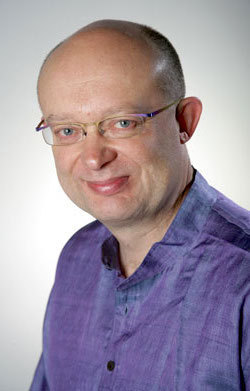Marc Abrahams's Blog, page 343
March 6, 2015
The Personalities of Numbers [part 3 of 3]: ‘Weird Numbers’
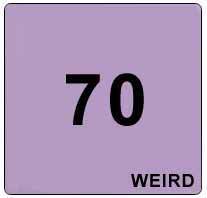 Numbers can be many things to many people. They can be Happy, Unhappy, Evil, or Odious. Perhaps now’s time to turn to Weird numbers (like 70)
Numbers can be many things to many people. They can be Happy, Unhappy, Evil, or Odious. Perhaps now’s time to turn to Weird numbers (like 70)
“A weird number is a number n for which σ(n)>2n and such that n is not a sum of distinct proper divisors of n.”
Here is maître-assistant Dr. Giuseppe Melfi of the Faculty of Economics and Business, at the University of Neuchâtel, Switzerland, explaining his paper ‘On the conditional infiniteness of primitive weird numbers’ which is published in the Journal of Number Theory, Volume 147, February 2015, Pages 508–514.
BONUS: May we robustly recommend the website(s) of Dr. Tanya Khovanova, who is a freelance mathematician and a Research Affiliate at the Mathematics Department of MIT.
Dr. Khovanova not only maintains a real-time online a number profiling service (just enter a number to discover its personality) but also provides a growing list of Number Gossip Properties – which inspired this short Improbable series.
March 5, 2015
Fractal Hamentaschen and Other Mathematical Baking
Among the more unusual arenas in which to construct fractals—objects with self-similar (or at least approximately self-similar) features on all scales—is in the kitchen.
For example, one might consider creating a fractal generalization of a hamentasch, a traditional Jewish pastry that consists of dough in the shape of a triangle along with a filling in the center.
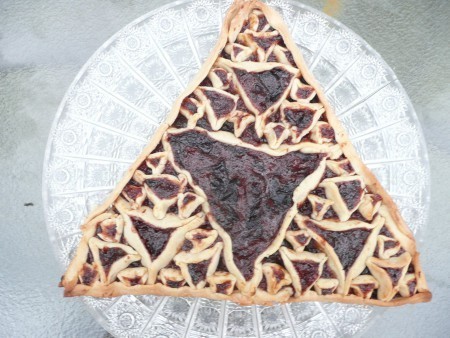
A Sierpinski hamentasch. Challenge: Can you measure the fractal dimension of this hamentasch?
A few years ago, a recipe was published on a Seattle Local Food blog for making Sierpinski Hamentaschen, which provided a solution to the ages-old problem of how to create a hamentaschen without having a dough:filling ratio that is too high. This was especially a problem at the ‘eat’ stage of the algorithm.
It turns out that the solution is surprisingly simple: take advantage of
mathematical knowledge about the Sierpinski triangle and create fractal hamentaschen.
Thankfully, mathematical baking is an active area. My own institution,
University of Oxford, even held a mathematical bake-off last fall.
(Thanks to investigator Karen Daniels for alerting us to the Sierpinski
hamentaschen.)
Lincoln Carr joins Luxuriant Former Hair Club (LFHCfS)
Lincoln Carr has joined the Luxuriant Former Hair Club for Scientists (LFHCfS). He says:
In graduate school I had luxuriant flowing hair. I foolishly accepted a post-doc in Paris where crazed mobs of Frenchmen chased me down and shaved me bald, shrieking, “Vive la France! Tu seras chauve, chien Américain!” While there, I also had a very bald baby. My hair has never grown back.
Lincoln D. Carr, Ph.D., LFHCfS
Professor, Humboldt Fellow, Honors Faculty Fellow
Department of Physics
Colorado School of Mines
Golden, Colorado, USA
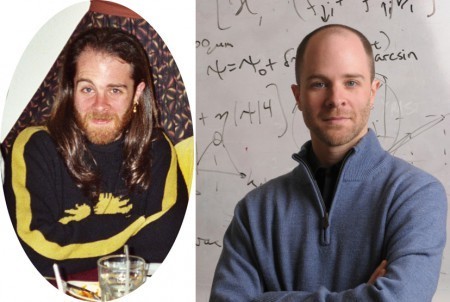
March 4, 2015
Introducing the Improbable Research weekly podcast: Podcast #1
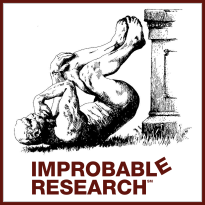 Today is the premiere of the weekly Improbable Research podcast. It’s all about research that makes people LAUGH, then THINK — research about anything and everything, from everywhere —research that’s good or bad, important or trivial, valuable or worthless.
Today is the premiere of the weekly Improbable Research podcast. It’s all about research that makes people LAUGH, then THINK — research about anything and everything, from everywhere —research that’s good or bad, important or trivial, valuable or worthless.
CBS is distributing the Improbable Research podcast, both on the new CBS Play.it web site, and on iTunes. (Improbable Research is one of the new, original podcasts CBS is distributing. CBS also has a number of podcasts of popular CBS radio programs and other longstanding CBS sources.)
Podcast #1: Homosexual necrophilia in the mallard duck
LISTEN on iTunes or Play.it. (Or DOWNLOAD it, and listen later)
SUBSCRIBE (to receive a new episode, FREE, every week) on iTunes or Play.it.
This week, Marc Abrahams tells about:
Homosexual necrophilia in the mallard duck. (“The First Case of Homosexual Necrophilia in the Mallard Anas platyrhynchos (Aves: Anatidae),” C.W. (Kees) Moeliker, Deinsea, vol. 8, 2001, pp. 243-7. / Kees Moeliker’s TED Talk. / De eendenman’ (The Duck Guy), 2009. / Dead Duck Day.)
The karaoke pandemic. (” Effect of Hydration and Vocal Rest on the Vocal Fatigue in Amateur Karaoke Singers,” E.M. Yiu and R.M. Chan, Journal of Voice, vol. 17, no. 2, June 2003, pp. 216-27.)
Artists’ suicides as economic boons. (Kurt Cobain / Cameron, Samuel, Bijou Yang, and David Lester (2005). ‘Artists’ Suicides as a Public Good,’ Archives of Suicide Research 9 (4): 389–96. / Lester, David (2003). ‘Suicide by Jumping From a Bridge,’ Perceptual and Motor Skills 97 (1): 338.)
Wascally wabbit wrapping. (Greenway, G. W., and R. E. Garcia Via (1977). ‘Designing and Testing an Improved Packaging for Large Hollow Chocolate Bunnies,’ TAPPI Journal, 80 (8): 133. / Vilela, P. M., and D .Thompson (1999). ‘Viscoelasticity: Why Plastic Bags Give Way When You Are Halfway Home,’ European Journal of Physics, vol. 20, no. 1, January 1999, pp. 15-20. )
Dr. Alias, the hair man. (Alias, A. G. (1996) ‘A Statistical Association Between Liberal Body Hair Growth and Intelligence.’ Presented at the Eighth Congress of the Association of European Psychiatrists, London, UK,12 July. (1995) /. ‘Top Ranked Boxers Are Less Hirsute Than Lower Level Boxers: An Example For the Importance of 5-Alpha-Reductase?’ Biological Psychiatry, 37 (9): 612–13. (1995). / ‘Non-Pathological Associational Loosening of Marlon Brando: A Sign of Hypoarousal?’ Biological Psychiatry, 37 (9): 613.)
The mind of the waiter. (Bekinschtein, Tristan A., Julian Cardozo, and Facundo F. Manes. ‘Strategies of Buenos Aires Waiters to Enhance Memory Capacity in a Real-Life Setting.’ Behavioural Neurology, 20: 65–70.)
Combing through the hair data. (Disney World /Robbins, Clarence, and Marjorie Gene Robbins (2003). ‘Scalp Hair Length. I. Hair Length in Florida Theme Parks: An Approximation of Hair Length in the United States of America,’ Journal of Cosmetic Science, 54 (1): 53–62.)
The Personalities of Numbers [part 2 of 3]
Some numbers might be Evil or Odious but others are Happy. A Happy number can be described like this:
“
If you iterate the process of summing the squares of the decimal digits of a number, then it is easy to see that you either reach the cycle 4→16→37→58→89→145→42→20→4 or arrive at 1. In the latter case you started from a happy number.”
The description comes from a paper in the Rocky Mountain Journal of Mathematics Volume 30, Number 2 (2000), pp. 565-570, entitled: ‘On Happy Numbers’ by professor Samir Siksek of the Mathematics Institute, University of Warwick, UK, and Esam El-Sedy [possibly a.k.a. Essam S. El-Sedy of the Ain Shams University Department of Mathematics]
“Several questions” say the team “are asked about happy numbers, including: ‘How many consecutive happy numbers can you have? Can there be arbitrarily many?’ It is the purpose of this paper to show that there are sequences of consecutive happy numbers of arbitrary length.” The paper makes progress towards the answers, and can be read in full here.
Note that if a number doesn’t satisfy the conditions described above, it must, lamentably, be an Unhappy Number, (a.k.a. a Sad Number) like 33.
Coming soon : Weird numbers
New penis survey follows in footsteps of Ig Nobel Prize-winning study
A new British survey of international penis size builds on — and cites — an earlier, Ig Nobel Prize-winning Canadian study.
The 1998 Ig Nobel Prize for statistics was awarded to Jerald Bain of Mt. Sinai Hospital in Toronto and Kerry Siminoski of the University of Alberta for their carefully measured report, “The Relationships Among Height, Penile Length, and Foot Size.” That study was published in Annals of Sex Research, vol. 6, no. 3, 1993, pp. 231-5.)
“Am I normal? A systematic review and construction of nomograms for flaccid and erect penis length and circumference in up to 15 521 men,” David Veale [pictured here], Sarah Miles, Sally Bramley, Gordon Muir and John Hodsoll, BJU International, epub March 2, 2015. The authors are at The Institute of Psychiatry, Psychology and Neuroscience, King’s College London Medical School, King’s College London,South London and Maudsley NHS Foundation Trust, King’s College NHS Foundation Trust, London, UK. The study takes its data from earlier studies done in many nations.
BONUS FACT (possibly unrelated): The number 15221, if treated as a postal zip code, identifies the city of Alum Bank, Pennsylvania, which is immediately south of Blue Knob State Park.
BONUS FACT (certainly related): The press officer for King’s College London Medical School, to whom all inquiries are directed, in the press release about this new study, is named Tom Bragg.
March 3, 2015
Effects of Parliamentary Elections on Suicide Rates in Hungary
Professor David Lester, the world’s most prolific writer of short research studies about suicide, has a new study:
“Effects of Parliamentary Elections on Suicide Rates in Hungary,” Tamás Zonda, Zoltán Kmetty, David Lester, Mónika Ditta Tóth, Crisis, epub 2015. The authors are at Hungarian Association for Suicide Prevention, Budapest, Hungary, Károli Gáspár University, Budapest, Hungary, The Richard Stockton College, Galloway, NJ, USA, and Semmelweis University, Budapest, Hungary.
Professor Lester and his co-authors report that parliamentary elections have no significant effects on suicide rates in Hungary.
* * *
Professor Lester is one of the most prolific paper producers in all of academia. If you have a few spare hours, glance at the list of his publications up through the year 2012, at which time Professor Lester had authored or co-authored 2574 academic papers.
March 2, 2015
Tyco’s ‘Piggy,’ Ig Nobel Prize winner, profiled
Dennis Kozlowski, who shared the 2002 Ig Nobel Prize for economics, is profiled in the March 1, 2015 issue of The New York Times.
That Ig Nobel Prize was awarded to the executives, corporate directors, and auditors of Enron, Lernaut & Hauspie [Belgium], Adelphia, Bank of Commerce and Credit International [Pakistan], Cendant, CMS Energy, Duke Energy, Dynegy, Gazprom [Russia], Global Crossing, HIH Insurance [Australia], Informix, Kmart, Maxwell Communications [UK], McKessonHBOC, Merrill Lynch, Merck, Peregrine Systems, Qwest Communications, Reliant Resources, Rent-Way, Rite Aid, Sunbeam, Tyco, Waste Management, WorldCom, Xerox, and Arthur Andersen, for adapting the mathematical concept of imaginary numbers for use in the business world. [NOTE: all companies are U.S.-based unless otherwise noted.]
Here are a few excerpts from the Times profile:
Tyco’s ‘Piggy,’ Out of Prison and Living Small
… In a two-bedroom rental on the 35th floor of a building overlooking the East River, L. Dennis Kozlowski lives with his new wife, Kimberly, in relative modesty — at least compared with his previous life as the extravagant chief of Tyco International….
Ten years and a lifetime ago, Mr. Kozlowski reigned as the archetype of avarice. This helped lead to his conviction in 2005 for looting nearly $100 million from Tyco, for which he served six and a half years in prison. [A $6,000 gold-and-burgundy] shower curtain was in his corporate residence on Fifth Avenue — paid for with Tyco funds — and came to symbolize a life of unabashed excess….
Then, it was over, swiftly. Mr. Kozlowski’s indictment for evading 8.25 percent sales tax on $14 million of artwork resulted in a broader Tyco internal investigation.
That led to new criminal charges, for which he was convicted of taking unauthorized bonuses, abusing corporate loan programs, falsifying records, and conspiracy. In addition to jail, Mr. Kozlowski had to pay $167 million in restitution and fines….
Today, he acknowledges making mistakes…. Even so, he maintains he was unfairly convicted, especially in light of how few big names were brought to trial in the most recent period of Wall Street malfeasance. “After 2008,” he said, “nobody was prosecuted.”
The Personalities of Numbers [part 1 of 3]
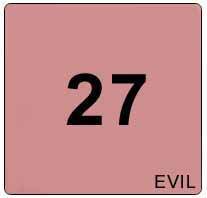 Some people love numbers. And some find them odious and evil. And others manage to embrace both positive and negative sentiments at the same time. Take for example, mathematicians Jean-Paul Allouche, Benoit Cloitre and Vladimir Shevelev who have authored a paper with a distinctively Nietzschean title : ‘Beyond odious and evil’ in: arXiv:1405.6214v1 [math.NT] 23 May 2014
Some people love numbers. And some find them odious and evil. And others manage to embrace both positive and negative sentiments at the same time. Take for example, mathematicians Jean-Paul Allouche, Benoit Cloitre and Vladimir Shevelev who have authored a paper with a distinctively Nietzschean title : ‘Beyond odious and evil’ in: arXiv:1405.6214v1 [math.NT] 23 May 2014
[Note: Odious numbers are numbers with an Odd number of 1s in their binary form. So, 13, which in binary is written 1101 is Odious.
Conversely, 27, which in binary is 11011, is Evil, because it has an Even number of 1s]
The conclusions that the team reach are difficult to summarise in a non-mathematical form, can we suggest that interested parties refer to the paper in full.
Coming soon: Happy numbers
March 1, 2015
Reaction to an imagined feminist dating partner
There’s no need to imagine your reaction to reading about a study about people reacting to an imagined feminist dating partner. Simply read the following, then note down your actual reaction:
“Power motivation as an influence on reaction to an imagined feminist dating partner,” Eugene M. Fodor, David P. Wick, and Nicole E. Conroy, Motivation and Emotion, vol. 36, no. 3, 2012, pp. 301-310.
“we conducted a simulated dating service experiment with college men who scored either high or low on the Picture Story Exercise (PSE) measure of power motivation and later observed a video displaying an interview with a hypothetical dating partner. From among the 203 men who completed the PSE, 96 took part in the experiment. The video presented an 8-min enactment by a young woman who came across either as an assertive feminist or as compliant and agreeable. Electromyographic responses from the corrugator supercilii (frown muscles) fit the premise of McClelland’s power-stress theory, as did scores on the Reysen Likability Scale and the Affective Attitudes Scale.”
BONUS (possibly unrelated): Marzi, C. A., F. Mancini, T. Metitieri, and S. Savazzi. “Retinal eccentricity effects on reaction time to imagined stimuli.” Neuropsychologia, 44, no. 8 (2006): 1489-1495.
Marc Abrahams's Blog
- Marc Abrahams's profile
- 14 followers


